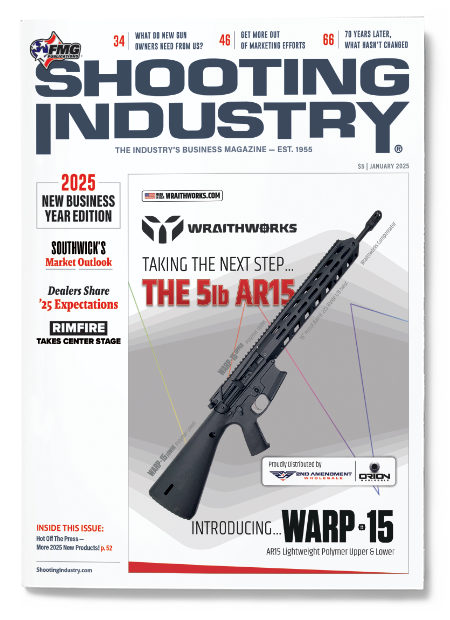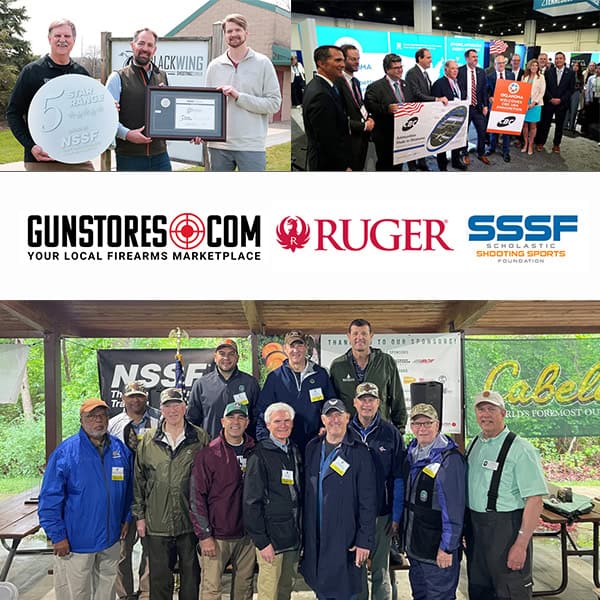5 Forces Poised To Shape 2025
Well, it’s time to say goodbye to 2024 and a year marked by inflation, lackluster sales and a contentious U.S. presidential election. Now we say hello to 2025 and all of its uncertainty.
It’s a perfect time to break out our forecasting hats and make educated guesses about what the coming year will bring. This year, we asked our panelists to tackle a range of topics including politics, the economy and what it’s going to take to be successful.
Our group: Paul Bastean, managing director of Ultimate Defense Firing Range & Training Center in St. Peters, Mo.; Larry Hyatt, owner of Hyatt Guns in Charlotte, N.C.; John Phillips, president of Poway Weapons & Gear in San Diego; and Mark Stevens, founder of firearms industry consulting firm The Syndicate, based in Minneapolis.
1. Politics: Still A Sales Driver?
Making it through the November elections without any chaos — and the Republican Party firmly in control of the federal government — leaves the industry in a mixed position.
On one hand, there’s little reason to fear new laws or rulings that would negatively impact gun rights. On the other, it’s not the kind of environment that sparks gun sales.
“When Trump won his first term, we had what we called the ‘Trump Slump,’” said Hyatt, in North Carolina. “Our gun business slowed down, we think, because people weren’t worried about restrictive laws being passed. They sort of took it out of the market.”
Likewise, 2025 could be another quiet year, with customers lacking the motivation that sends them into gun stores in droves. And it may be more than just a 2025 problem, suggests Phillips, in California.
“My worry is it’s not going to be just this year,” he predicted. “My worry is it’s going to be at least the next three years. I think it’s going to be a grind for our industry.”
But do politics even matter? Bastean, in Missouri, questions whether our elected leaders influence gun-buying habits. The economy, he argues, is a much stronger factor.
“The American population has gotten to the point where they just don’t pay attention to people stomping their feet so much anymore,” he said.
Indeed, recent historical events have given us a pretty high bar — in terms of what it might take to spark emotion-based buying.
“How do you create more fear than a pandemic and a riot at this point?” questioned Stevens, in Minnesota. “Anyone who lived through 2020 knows anything new in terms of demand is going to feel like a drop in the pond.”
2. A Stable Economy Will Be Key
Less volatility isn’t necessarily a bad thing, of course. Stevens expects the economy to be more stable.
“Let’s just have a good year,” he stated. “We don’t have to have a great year. We don’t have to have a terrible year. We could just have a good year.”
There are, however, potential wildcards — particularly Trump’s promise to aggressively employ tariffs on imported goods, which will elevate costs.
“The big question right now is whether or not we’re going to see tariffs on things like Chinese steel, which our industry relies on,” Stevens noted. “If raw materials go up, there will be inflation in pricing in the firearms industry. How it gets navigated is anyone’s guess.”
Bastean is optimistic inflationary pressures will continue to decline. Even if tariffs cause short-term pain, they should spur more American-based production. It’s also impossible to ignore the impact this perception has on the economy, he added.
“I think there are a lot of people who have a lot more faith in the Donald Trump economy than they did the Joe Biden economy,” he said. “I think we’ll see more people spending than we did with the Biden administration.”
There’s little reason, however, to expect significant changes in the labor market. Finding and keeping good employees is likely to remain a tall task for everyone.
In California, the state’s rising minimum wage requirements have forced Poway Weapons & Gear to push wages even higher for its employees.
“It certainly has added to the cost of business, and we passed it on through our range time and other costs,” Phillips shared. “Finding employees is a challenge, so we’re exploring ways to motivate or incentivize existing employees to stay with us.”
In North Carolina, Hyatt says labor costs are particularly high compared to four or five years ago. The biggest challenge has been staffing the store’s technology department, which handles key tasks, including online sales, inventory management and compliance.
“We had to farm it out to a company that has a lot of employees and they’re available 24/7,” Hyatt said.
Overall, the labor pool has been a bit better lately, but it still costs more to keep the best workers. And it’s not easy to replace them if they leave.
“You hire three to get one. No matter what the resume says or what you learn in the interview, you don’t know who you’ve hired,” Hyatt explained. “After a couple months, when the honeymoon is over, that’s when you know what type of employee you have. And it doesn’t always work out.”
3. Innovation — Beyond New Products
As things stand, there doesn’t appear to be a lot to get excited about in terms of new products coming down the line. But that’s not particularly news, Hyatt suggests.
“In the past few years, we haven’t had a huge number of new products,” he said. “We’re always going to see a new caliber introduced, but not all of them catch on. It’s a pretty conservative business.”
At his store, small handguns are still drawing the most interest from customers. And the demand for handgun optics is on the rise.
Missouri’s Bastean has a similar take.
“We’ve done everything we could possibly do to a handgun, a rifle and a shotgun,” he noted. “For the past couple years there hasn’t been anything revolutionizing the industry. And I don’t believe we’ll see it for a while, especially if we see a slowdown in the firearms industry in Trump’s second or third year.”
But it doesn’t mean there isn’t room for innovation at some point.
“I think there absolutely is,” Bastean said. “We’ve seen some innovation with the red dot sights. They’ve gotten smaller, they’ve gotten more resilient and more used to abuse.”
Stores in California, on the other hand, are dealing with a different landscape, thanks to the state handgun roster that limits which guns can be sold there. Last year saw the addition of about a dozen key guns, with more coming in 2025.
“This has certainly kept the firearm sales up higher than what they would have been had it not happened,” Phillips observed.
When Stevens thinks of innovation, he sees it from an overall perspective — rather than what any particular gunmaker is doing. He points to steady improvements in manufacturing processes that have helped gunmakers build better guns, more efficiently.
“It’s almost like an under-the-radar innovation,” he said. “Maybe you won’t even be able to see it but you’ll know the result. If last year it took you 18 months to get the pistol you wanted, this year it took you nine. This is significant.”
4. Alternate Revenues
If you can’t count on unrest, political pressures or some dazzling new innovation to spark gun sales, it may be time to take a hard look at other ways to generate revenue. Simply putting a “guns for sale” sign out front probably won’t be enough to succeed this year.
With this in mind, Stevens urges shops to look beyond the gun. Instead of waiting for customers to come through the door, find ways to encourage them to come in. This can be done with promotions, training, range competitions, classes, memberships and digital content created for customers.
“Think training. Think memberships. Think community building inside of our space,” Stevens added. “Whether it’s consumers, gunsmiths or manufacturers, there’s just tons of money to be made by bringing people together. This is something we’ve historically been terrible at.”
In North Carolina, Hyatt puts a heavy emphasis on training through an outdoor range able to handle rifle, pistol and shotgun classes. Without an indoor range, they don’t do as well as some competitors when it comes to concealed carry classes. Instead, they focus on precision rifle, AR-15s and sporting clays.
“We can do things you can’t do at an indoor range, particularly with rifles and shotguns and moving around,” Hyatt shared.
While not everyone feels comfortable with the strategy, Hyatt’s shop charges a $29 paperwork processing fee with all gun sales. It offsets one of the advantages online gun stores have — in not having to deal with customer paperwork. They also offer a $49 service to help consumers sell to each other.
“There is room in our industry as the paperwork processor to help individuals sell their guns to other individuals and get a fee-based business on it,” Hyatt said.
Monthly and annual memberships can also provide a steady stream of income. Offering discounted training, range fees, product discounts and access to exclusive sales events can also help build loyalty.
“Our membership revenue is one of our most significant revenue streams,” noted Phillips.
One of the keys is having a staff dedicated to boosting those membership numbers by helping customers understand the value.
“We’re always out showing people how they can lower their overall range costs,” Phillips added. “And we help them find discounts on the products they’re buying in order to train and stay efficient.”
In Missouri, Bastean touts the store’s strategy as a three-pronged approach built around the retail shop, range and training classes: It’s a place to buy a gun and accessories — and to get knowledge and experience needed to use them effectively.
“You have to have knowledge and experience to go with the tool,” Bastean said. “It just so happens the knowledge and experience are profit centers for us. It’s the least amount of overhead with the most amount of return.”
5. The Bottom Line
So, what is it going to take be successful in 2025?
Bastean argues it will take dexterity, an ability to quickly read customer needs and offering something other than guns.
“Being prepared to have the right product at the right time is going to make a pretty big difference in how much success you see,” he said. “The margin on guns is getting so cutthroat. Having some service or product with a higher profit margin is going to be essential to survival.”
For Phillips, the key is running an efficient organization.
“I mean pricing, labor and incentives, whether it’s customer incentives or employee incentives,” he shared. “You’re going to have to be very cost conscious and focused on trying to make great experiences for customers so you’re able to pull them back into the shop.”
Hyatt sees ready access to cash as an important tool for 2025. He worries some stores may already be hobbled by deep inventories accumulated in the wake of the COVID pandemic.
“They can’t buy what sells because they’ve got their money tied up in stuff that doesn’t,” Hyatt said. “This is a real risk for the gun industry. Getting rid of this excess inventory so they can participate in the business world is going to be critical, because this is a very capital-intensive business.”
Stevens’ advice is to remember customers, particularly in a quiet economy, have tremendous power. They often have many options for how they spend their money.
“Give a damn about your customers. That’s number one,” he advised.
“They don’t need any of this. This isn’t bread. This isn’t steak,” he continued. “If you already have one or two defensive handguns in your household or whatever hunting equipment you need, you don’t need anything else. It’s all wants at that point. So treat your customers awesome, and they’ll take care of you forever.”






